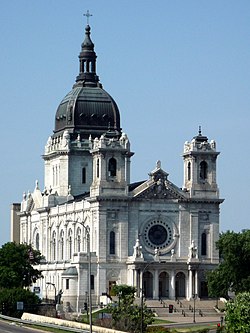Basilica of Saint Mary, Minneapolis
|
The Basilica of Saint Mary–Catholic
|
|

The Basilica of Saint Mary in 2008
|
|
| Location | 1600 Hennepin Ave. Minneapolis, Minnesota |
|---|---|
| Coordinates | 44°58′23″N 93°17′11″W / 44.97306°N 93.28639°WCoordinates: 44°58′23″N 93°17′11″W / 44.97306°N 93.28639°W |
| Area | 2.5 acres (1.0 ha) |
| Built | 1907–1914 |
| Architect | Masqueray, E.L. |
| Architectural style | Classical Revival, Other |
| NRHP Reference # | 75000985 |
| Added to NRHP | March 26, 1975 |
The Basilica of Saint Mary is a Roman Catholic minor basilica located on its own city block along Hennepin Avenue between 16th & 17th Streets in downtown Minneapolis, Minnesota. It was the first basilica established in the United States. The Basilica of Saint Mary is the co-cathedral of the Roman Catholic Archdiocese of Saint Paul and Minneapolis.
The Basilica of Saint Mary replaced a previous church, the Church of the Immaculate Conception. It was originally built in 1871, located at 3rd Street and 3rd Avenue North, but the expanding warehouse district was engulfing the church property. Archbishop John Ireland announced plans for a new Church of the Immaculate Conception on Christmas Day, 1903. In 1905, Lawrence S. Donaldson donated a one-block parcel on Hennepin Avenue near Loring Park for the new church buildings. The design was awarded to Franco-American architect Emmanuel Louis Masqueray, the designer of the Cathedral of Saint Paul. Masqueray designed it in the Classical/Baroque style. The groundbreaking was held on August 7, 1907, with foundation construction continuing through May 1908. The cornerstone was laid on May 31, 1908, with a ceremony involving 30,000 Catholics, twenty bishops, 300 priests and seminarians from the Saint Paul Seminary, and 500 cadets from the College of Saint Thomas. As construction on the Basilica and the St. Paul Cathedral progressed, Masqueray's architectural genius attracted attention. American Architect magazine commented, "The two Catholic Cathedrals will be -- when completed, noteworthy achievements in church building for any period; in extent and splendor they promise to surpass anything yet attempted in ecclesiastical work in the United States."
...
Wikipedia


